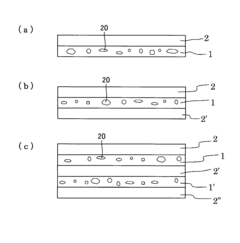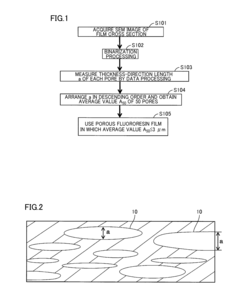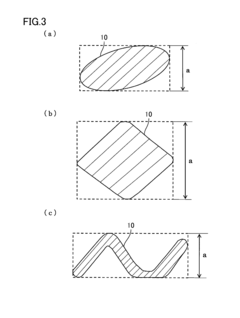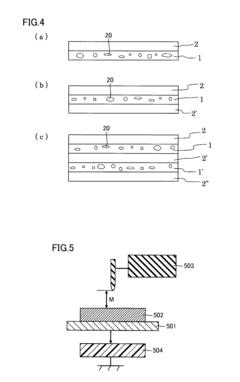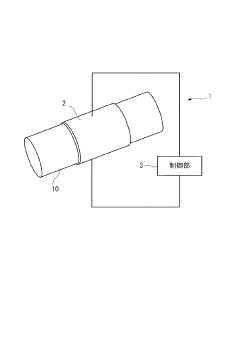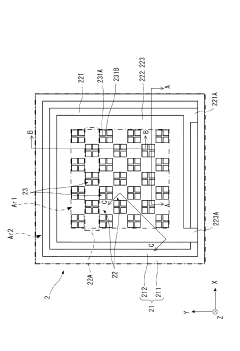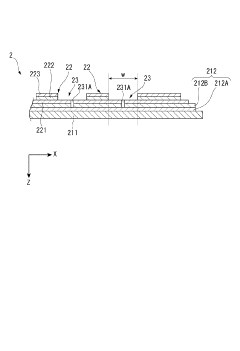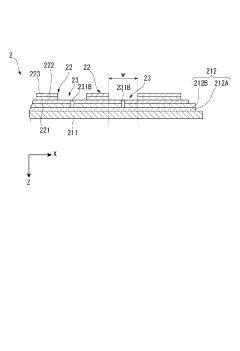Development of Ultra-bendable Piezoelectric Films
JUL 17, 20259 MIN READ
Generate Your Research Report Instantly with AI Agent
Patsnap Eureka helps you evaluate technical feasibility & market potential.
Piezoelectric Film Evolution and Objectives
Piezoelectric films have undergone significant evolution since their discovery in the mid-20th century. Initially, these materials were rigid and limited in their applications. However, advancements in materials science and nanotechnology have paved the way for the development of increasingly flexible and bendable piezoelectric films. This evolution has been driven by the growing demand for wearable electronics, soft robotics, and energy harvesting devices in various industries.
The journey towards ultra-bendable piezoelectric films began with the exploration of organic piezoelectric materials, such as polyvinylidene fluoride (PVDF) and its copolymers. These materials offered improved flexibility compared to traditional ceramic piezoelectrics but still had limitations in terms of bendability and performance. Subsequent research focused on enhancing the piezoelectric properties of these organic materials through various techniques, including nanocomposite formation and molecular engineering.
In recent years, the field has witnessed a paradigm shift with the emergence of two-dimensional (2D) materials and their incorporation into piezoelectric films. Materials like molybdenum disulfide (MoS2) and hexagonal boron nitride (h-BN) have shown exceptional piezoelectric properties at the nanoscale, opening up new possibilities for ultra-bendable piezoelectric films. These 2D materials, when combined with flexible polymers, have resulted in hybrid structures that exhibit both high piezoelectric performance and extreme bendability.
The primary objective in the development of ultra-bendable piezoelectric films is to achieve a perfect balance between flexibility and piezoelectric output. Researchers aim to create films that can withstand extreme bending angles, potentially up to 180 degrees, without compromising their ability to generate electrical signals in response to mechanical stress. This goal presents significant challenges, including maintaining structural integrity under repeated bending cycles and ensuring uniform piezoelectric response across the entire film surface.
Another crucial objective is to enhance the scalability and manufacturability of these ultra-bendable films. While laboratory-scale prototypes have shown promising results, transitioning these technologies to large-scale production remains a significant hurdle. Researchers are exploring various fabrication techniques, such as roll-to-roll processing and 3D printing, to address this challenge and make ultra-bendable piezoelectric films commercially viable.
Furthermore, the development of these films aims to expand their application spectrum. Beyond traditional uses in sensors and actuators, ultra-bendable piezoelectric films hold immense potential in emerging fields like biomedical implants, smart textiles, and self-powered IoT devices. The ability to conform to complex surfaces and generate power from subtle movements could revolutionize these sectors, driving innovation and creating new market opportunities.
The journey towards ultra-bendable piezoelectric films began with the exploration of organic piezoelectric materials, such as polyvinylidene fluoride (PVDF) and its copolymers. These materials offered improved flexibility compared to traditional ceramic piezoelectrics but still had limitations in terms of bendability and performance. Subsequent research focused on enhancing the piezoelectric properties of these organic materials through various techniques, including nanocomposite formation and molecular engineering.
In recent years, the field has witnessed a paradigm shift with the emergence of two-dimensional (2D) materials and their incorporation into piezoelectric films. Materials like molybdenum disulfide (MoS2) and hexagonal boron nitride (h-BN) have shown exceptional piezoelectric properties at the nanoscale, opening up new possibilities for ultra-bendable piezoelectric films. These 2D materials, when combined with flexible polymers, have resulted in hybrid structures that exhibit both high piezoelectric performance and extreme bendability.
The primary objective in the development of ultra-bendable piezoelectric films is to achieve a perfect balance between flexibility and piezoelectric output. Researchers aim to create films that can withstand extreme bending angles, potentially up to 180 degrees, without compromising their ability to generate electrical signals in response to mechanical stress. This goal presents significant challenges, including maintaining structural integrity under repeated bending cycles and ensuring uniform piezoelectric response across the entire film surface.
Another crucial objective is to enhance the scalability and manufacturability of these ultra-bendable films. While laboratory-scale prototypes have shown promising results, transitioning these technologies to large-scale production remains a significant hurdle. Researchers are exploring various fabrication techniques, such as roll-to-roll processing and 3D printing, to address this challenge and make ultra-bendable piezoelectric films commercially viable.
Furthermore, the development of these films aims to expand their application spectrum. Beyond traditional uses in sensors and actuators, ultra-bendable piezoelectric films hold immense potential in emerging fields like biomedical implants, smart textiles, and self-powered IoT devices. The ability to conform to complex surfaces and generate power from subtle movements could revolutionize these sectors, driving innovation and creating new market opportunities.
Market Demand Analysis for Ultra-bendable Films
The market demand for ultra-bendable piezoelectric films has been steadily growing across various industries, driven by the increasing need for flexible and wearable electronics. These films offer unique advantages in energy harvesting, sensing, and actuation applications, making them highly desirable in sectors such as healthcare, consumer electronics, and automotive.
In the healthcare industry, ultra-bendable piezoelectric films are finding applications in wearable medical devices and implantable sensors. The global wearable medical devices market is expected to reach significant growth in the coming years, with a substantial portion attributed to flexible and bendable technologies. These films enable the development of comfortable, non-invasive health monitoring devices that can conform to the human body, providing continuous data collection for improved patient care and early disease detection.
The consumer electronics sector is another major driver of demand for ultra-bendable piezoelectric films. As the trend towards flexible and foldable devices continues to gain momentum, manufacturers are seeking innovative materials to enable new form factors and functionalities. These films can be integrated into smartphones, tablets, and wearable devices to create touch-sensitive surfaces, haptic feedback systems, and energy harvesting components. The flexible display market, which heavily relies on bendable technologies, is projected to experience substantial growth in the near future.
In the automotive industry, ultra-bendable piezoelectric films are being explored for various applications, including energy harvesting from vehicle vibrations, touch-sensitive control panels, and advanced sensor systems. As vehicles become more electrified and autonomous, the demand for lightweight, flexible, and energy-efficient components is increasing. The automotive piezoelectric devices market is expected to grow significantly, driven by the adoption of advanced driver assistance systems (ADAS) and the push towards electric vehicles.
The energy harvesting capabilities of ultra-bendable piezoelectric films are also attracting attention in the Internet of Things (IoT) and smart infrastructure sectors. These films can be used to power small, wireless sensors and devices by converting mechanical energy from the environment into electrical energy. As the number of connected devices continues to proliferate, the demand for self-powered sensors and energy-efficient solutions is expected to drive the growth of the piezoelectric energy harvesting market.
While the market potential for ultra-bendable piezoelectric films is promising, there are still challenges to overcome. These include scaling up production to meet industrial demands, improving the durability and reliability of the films in various environmental conditions, and reducing manufacturing costs. As research and development efforts continue to address these challenges, the market for ultra-bendable piezoelectric films is expected to expand further, opening up new opportunities across multiple industries.
In the healthcare industry, ultra-bendable piezoelectric films are finding applications in wearable medical devices and implantable sensors. The global wearable medical devices market is expected to reach significant growth in the coming years, with a substantial portion attributed to flexible and bendable technologies. These films enable the development of comfortable, non-invasive health monitoring devices that can conform to the human body, providing continuous data collection for improved patient care and early disease detection.
The consumer electronics sector is another major driver of demand for ultra-bendable piezoelectric films. As the trend towards flexible and foldable devices continues to gain momentum, manufacturers are seeking innovative materials to enable new form factors and functionalities. These films can be integrated into smartphones, tablets, and wearable devices to create touch-sensitive surfaces, haptic feedback systems, and energy harvesting components. The flexible display market, which heavily relies on bendable technologies, is projected to experience substantial growth in the near future.
In the automotive industry, ultra-bendable piezoelectric films are being explored for various applications, including energy harvesting from vehicle vibrations, touch-sensitive control panels, and advanced sensor systems. As vehicles become more electrified and autonomous, the demand for lightweight, flexible, and energy-efficient components is increasing. The automotive piezoelectric devices market is expected to grow significantly, driven by the adoption of advanced driver assistance systems (ADAS) and the push towards electric vehicles.
The energy harvesting capabilities of ultra-bendable piezoelectric films are also attracting attention in the Internet of Things (IoT) and smart infrastructure sectors. These films can be used to power small, wireless sensors and devices by converting mechanical energy from the environment into electrical energy. As the number of connected devices continues to proliferate, the demand for self-powered sensors and energy-efficient solutions is expected to drive the growth of the piezoelectric energy harvesting market.
While the market potential for ultra-bendable piezoelectric films is promising, there are still challenges to overcome. These include scaling up production to meet industrial demands, improving the durability and reliability of the films in various environmental conditions, and reducing manufacturing costs. As research and development efforts continue to address these challenges, the market for ultra-bendable piezoelectric films is expected to expand further, opening up new opportunities across multiple industries.
Current Challenges in Piezoelectric Film Flexibility
The development of ultra-bendable piezoelectric films faces several significant challenges that hinder their widespread application and commercialization. One of the primary obstacles is achieving high flexibility without compromising the piezoelectric performance. Traditional piezoelectric materials, such as lead zirconate titanate (PZT), are inherently brittle and prone to cracking when subjected to extreme bending. This limitation restricts their use in applications requiring high flexibility, such as wearable electronics or conformal sensors.
Another major challenge lies in the trade-off between flexibility and piezoelectric output. As films become thinner and more flexible, their ability to generate significant electrical signals often diminishes. This reduction in performance is particularly problematic for energy harvesting applications, where maximizing power output is crucial. Researchers are actively seeking novel material compositions and structural designs to overcome this limitation and maintain high piezoelectric coefficients in ultra-thin films.
The integration of flexible piezoelectric films with other electronic components presents additional hurdles. Ensuring robust electrical connections and maintaining film integrity during the manufacturing process can be challenging, especially when dealing with extremely thin and bendable materials. Furthermore, the development of suitable encapsulation techniques to protect the films from environmental factors while preserving their flexibility remains an ongoing area of research.
Scalability and cost-effectiveness pose significant challenges in the production of ultra-bendable piezoelectric films. Current fabrication methods often involve complex processes or expensive materials, limiting their potential for large-scale manufacturing. Developing economically viable production techniques that can maintain consistent quality and performance across large areas is crucial for the widespread adoption of these films in commercial applications.
Lastly, the long-term stability and reliability of ultra-bendable piezoelectric films under repeated mechanical stress and environmental exposure remain concerns. Ensuring that these films can maintain their performance characteristics over extended periods of use, particularly in demanding applications such as implantable medical devices or structural health monitoring systems, is essential for their practical implementation. Addressing these challenges requires interdisciplinary efforts, combining materials science, electrical engineering, and manufacturing technologies to push the boundaries of piezoelectric film flexibility and performance.
Another major challenge lies in the trade-off between flexibility and piezoelectric output. As films become thinner and more flexible, their ability to generate significant electrical signals often diminishes. This reduction in performance is particularly problematic for energy harvesting applications, where maximizing power output is crucial. Researchers are actively seeking novel material compositions and structural designs to overcome this limitation and maintain high piezoelectric coefficients in ultra-thin films.
The integration of flexible piezoelectric films with other electronic components presents additional hurdles. Ensuring robust electrical connections and maintaining film integrity during the manufacturing process can be challenging, especially when dealing with extremely thin and bendable materials. Furthermore, the development of suitable encapsulation techniques to protect the films from environmental factors while preserving their flexibility remains an ongoing area of research.
Scalability and cost-effectiveness pose significant challenges in the production of ultra-bendable piezoelectric films. Current fabrication methods often involve complex processes or expensive materials, limiting their potential for large-scale manufacturing. Developing economically viable production techniques that can maintain consistent quality and performance across large areas is crucial for the widespread adoption of these films in commercial applications.
Lastly, the long-term stability and reliability of ultra-bendable piezoelectric films under repeated mechanical stress and environmental exposure remain concerns. Ensuring that these films can maintain their performance characteristics over extended periods of use, particularly in demanding applications such as implantable medical devices or structural health monitoring systems, is essential for their practical implementation. Addressing these challenges requires interdisciplinary efforts, combining materials science, electrical engineering, and manufacturing technologies to push the boundaries of piezoelectric film flexibility and performance.
Existing Ultra-bendable Film Solutions
01 Flexible piezoelectric films
Development of bendable piezoelectric films that can maintain their functionality while being flexed or curved. These films are designed to be thin and pliable, allowing for integration into various flexible electronic devices and wearable technologies.- Flexible piezoelectric films: Piezoelectric films can be designed to be flexible and bendable, allowing for their integration into curved or non-planar surfaces. These films maintain their piezoelectric properties while being able to conform to various shapes, making them suitable for applications in wearable devices, sensors, and energy harvesters.
- Composite structures for improved bendability: Composite structures incorporating piezoelectric materials can enhance the bendability of the films. These structures may include multiple layers or combinations of different materials to achieve the desired flexibility while maintaining piezoelectric performance. Such composites can be tailored for specific applications requiring both bendability and piezoelectric functionality.
- Thin-film technology for enhanced flexibility: Utilizing thin-film technology in the production of piezoelectric films can significantly improve their bendability. By reducing the thickness of the piezoelectric layer, the overall flexibility of the film increases, allowing for greater deformation without compromising the piezoelectric properties. This approach is particularly useful in creating highly flexible and conformable piezoelectric devices.
- Substrate selection for bendable piezoelectric films: The choice of substrate material plays a crucial role in determining the bendability of piezoelectric films. Flexible substrates, such as polymers or thin metal foils, can be used to support the piezoelectric layer, allowing for greater overall flexibility of the device. The substrate material must be carefully selected to ensure compatibility with the piezoelectric material and the intended application.
- Nanostructured piezoelectric materials for flexibility: Incorporating nanostructured piezoelectric materials, such as nanowires or nanoparticles, into films can enhance their bendability. These nanostructures can provide improved flexibility and mechanical properties compared to bulk piezoelectric materials, while maintaining or even enhancing the piezoelectric response. This approach allows for the development of highly flexible and efficient piezoelectric devices.
02 Composite materials for improved bendability
Utilization of composite materials to enhance the bendability of piezoelectric films. These composites often combine piezoelectric materials with flexible polymers or other substrates to achieve a balance between piezoelectric performance and mechanical flexibility.Expand Specific Solutions03 Nanostructured piezoelectric films
Implementation of nanostructures in piezoelectric films to improve bendability while maintaining or enhancing piezoelectric properties. These nanostructures can include nanowires, nanofibers, or nanoparticles incorporated into the film structure.Expand Specific Solutions04 Fabrication techniques for bendable piezoelectric films
Development of specialized fabrication techniques to produce highly bendable piezoelectric films. These methods may include novel deposition processes, etching techniques, or post-processing treatments to enhance film flexibility without compromising piezoelectric performance.Expand Specific Solutions05 Applications of bendable piezoelectric films
Exploration of various applications for bendable piezoelectric films, including energy harvesting devices, flexible sensors, and actuators. These applications leverage the films' ability to generate electrical signals in response to mechanical deformation, even when bent or flexed.Expand Specific Solutions
Key Players in Flexible Piezoelectric Industry
The development of ultra-bendable piezoelectric films is in an emerging stage, with significant potential for growth in flexible electronics and sensor applications. The market size is expanding rapidly, driven by increasing demand for wearable devices and IoT sensors. Technologically, while progress has been made, there's still room for improvement in flexibility, durability, and performance. Key players like FUJIFILM Corp., Murata Manufacturing, and Panasonic Holdings are leading research efforts, leveraging their expertise in materials science and electronics. Universities such as Tokyo Institute of Technology and South China University of Technology are contributing to fundamental research, while startups like Suzhou Nengstar Electronic Technology are focusing on innovative applications. The competitive landscape is diverse, with both established corporations and emerging companies vying for market share.
FUJIFILM Corp.
Technical Solution: FUJIFILM has developed ultra-bendable piezoelectric films using their proprietary organic piezoelectric material LATP (Lactic acid / L-tartaric acid / Phosphoric acid). This material exhibits a high piezoelectric constant of d33 = -32 pC/N[1], allowing for efficient energy harvesting and sensing capabilities. The films are fabricated using a solution-based process, enabling large-area and flexible production. FUJIFILM's technology incorporates a unique molecular design that enhances the alignment of dipoles within the film, resulting in improved piezoelectric performance. The films can be bent to a radius of curvature as small as 5 mm without significant degradation in performance[2], making them suitable for integration into wearable devices and conformal sensors.
Strengths: High flexibility, large-area production capability, and good piezoelectric performance. Weaknesses: May have lower temperature stability compared to inorganic piezoelectrics, and potential long-term reliability issues in harsh environments.
Murata Manufacturing Co. Ltd.
Technical Solution: Murata has developed ultra-thin piezoelectric films using advanced sputtering techniques to deposit oriented lead zirconate titanate (PZT) on flexible polymer substrates. Their process allows for precise control of film thickness down to 1 μm while maintaining excellent piezoelectric properties[3]. The company has implemented a unique stress control method during deposition to minimize internal stresses, enabling the films to achieve a bending radius of less than 3 mm without cracking[4]. Murata's films exhibit a high figure of merit (FOM) for energy harvesting applications, with a reported power density of up to 10 μW/cm² under typical vibration conditions[5]. The company has also developed specialized electrode designs to enhance the mechanical durability of the films under repeated bending cycles.
Strengths: Excellent piezoelectric properties in ultra-thin films, high bendability, and good power output for energy harvesting. Weaknesses: Use of lead-based materials may face regulatory challenges in some markets, and the sputtering process may limit scalability for very large area production.
Core Innovations in Flexible Piezoelectric Materials
Piezoelectric element including fluororesin film
PatentActiveUS20150015120A1
Innovation
- A piezoelectric element comprising a porous fluororesin film with a nonporous fluororesin layer stacked on at least one surface, where the average thickness-direction length of the top 50 pores is 3 μm or smaller, and a porosity of 10 to 40%, made from polytetrafluoroethylene or similar materials, enhancing piezoelectricity and heat resistance while maintaining transparency.
Piezoelectric film, piezoelectric module, and manufacturing method for piezoelectric film
PatentActiveJP2019110179A
Innovation
- A piezoelectric film with a flexible substrate and inorganic piezoelectric elements arranged in a two-dimensional array, allowing vibration without thickness changes and using slit grooves to enhance flexibility and output high-pressure ultrasonic waves.
Environmental Impact of Piezoelectric Film Production
The production of piezoelectric films, particularly ultra-bendable variants, raises significant environmental concerns that warrant careful consideration. The manufacturing process typically involves the use of various chemicals and materials, some of which may have adverse effects on the environment if not properly managed.
One of the primary environmental impacts stems from the synthesis of piezoelectric materials. Many piezoelectric films are based on lead zirconate titanate (PZT) or other lead-containing compounds. The production and disposal of lead-based materials pose serious environmental risks, including soil and water contamination. This has led to increased research into lead-free alternatives, such as barium titanate or potassium sodium niobate, which offer more environmentally friendly options but may present their own challenges in terms of performance and production.
The fabrication of ultra-bendable piezoelectric films often requires the use of polymer substrates and organic solvents. These materials can contribute to air and water pollution if not properly handled and disposed of. Additionally, the energy-intensive nature of certain production steps, such as high-temperature sintering or vacuum deposition, results in increased carbon emissions and energy consumption.
Waste management is another critical aspect of the environmental impact. The production process generates various forms of waste, including chemical byproducts, unused materials, and defective films. Proper disposal and recycling protocols are essential to minimize the environmental footprint of piezoelectric film production.
Water usage is a significant concern, particularly in areas where water scarcity is an issue. The cleaning and processing stages of film production often require substantial amounts of water, which must be treated before being released back into the environment.
On a positive note, the development of ultra-bendable piezoelectric films has the potential to contribute to more sustainable energy solutions. These films can be used in energy harvesting applications, converting mechanical energy from various sources into electrical energy, potentially reducing reliance on traditional power sources and lowering overall energy consumption.
To mitigate the environmental impact, manufacturers are increasingly adopting green chemistry principles and exploring more sustainable production methods. This includes the development of water-based processes, the use of biodegradable substrates, and the implementation of closed-loop recycling systems to recover and reuse materials.
As the demand for piezoelectric films grows, particularly in flexible electronics and wearable technology, it is crucial to balance technological advancement with environmental responsibility. Ongoing research into eco-friendly materials and production techniques will be vital in ensuring the sustainable development of this promising technology.
One of the primary environmental impacts stems from the synthesis of piezoelectric materials. Many piezoelectric films are based on lead zirconate titanate (PZT) or other lead-containing compounds. The production and disposal of lead-based materials pose serious environmental risks, including soil and water contamination. This has led to increased research into lead-free alternatives, such as barium titanate or potassium sodium niobate, which offer more environmentally friendly options but may present their own challenges in terms of performance and production.
The fabrication of ultra-bendable piezoelectric films often requires the use of polymer substrates and organic solvents. These materials can contribute to air and water pollution if not properly handled and disposed of. Additionally, the energy-intensive nature of certain production steps, such as high-temperature sintering or vacuum deposition, results in increased carbon emissions and energy consumption.
Waste management is another critical aspect of the environmental impact. The production process generates various forms of waste, including chemical byproducts, unused materials, and defective films. Proper disposal and recycling protocols are essential to minimize the environmental footprint of piezoelectric film production.
Water usage is a significant concern, particularly in areas where water scarcity is an issue. The cleaning and processing stages of film production often require substantial amounts of water, which must be treated before being released back into the environment.
On a positive note, the development of ultra-bendable piezoelectric films has the potential to contribute to more sustainable energy solutions. These films can be used in energy harvesting applications, converting mechanical energy from various sources into electrical energy, potentially reducing reliance on traditional power sources and lowering overall energy consumption.
To mitigate the environmental impact, manufacturers are increasingly adopting green chemistry principles and exploring more sustainable production methods. This includes the development of water-based processes, the use of biodegradable substrates, and the implementation of closed-loop recycling systems to recover and reuse materials.
As the demand for piezoelectric films grows, particularly in flexible electronics and wearable technology, it is crucial to balance technological advancement with environmental responsibility. Ongoing research into eco-friendly materials and production techniques will be vital in ensuring the sustainable development of this promising technology.
Standardization and Testing Protocols
The development of ultra-bendable piezoelectric films requires robust standardization and testing protocols to ensure consistency, reliability, and comparability of research results across different laboratories and applications. These protocols are essential for validating the performance and durability of these innovative materials under various conditions.
A comprehensive standardization framework for ultra-bendable piezoelectric films should encompass several key aspects. Firstly, it must define standard sample preparation methods, including film thickness, substrate materials, and deposition techniques. This ensures that researchers can reproduce and compare results effectively. Secondly, the framework should establish uniform testing conditions, such as temperature, humidity, and mechanical stress parameters, to simulate real-world applications accurately.
Testing protocols for ultra-bendable piezoelectric films should include both static and dynamic measurements. Static tests typically involve measuring the piezoelectric coefficients, Young's modulus, and electrical properties of the films. Dynamic tests, on the other hand, assess the films' performance under various bending conditions, including different radii of curvature and cycling frequencies. These tests should also evaluate the films' fatigue resistance and long-term stability.
Standardized characterization techniques are crucial for assessing the films' microstructure, crystallinity, and surface morphology. Techniques such as X-ray diffraction (XRD), scanning electron microscopy (SEM), and atomic force microscopy (AFM) should be employed following established protocols to ensure consistent and comparable results across different research groups.
Electrical characterization protocols should include standardized methods for measuring the films' output voltage, current, and power under various mechanical deformations. These measurements should be performed using calibrated equipment and following specific procedures to minimize errors and ensure reproducibility.
To address the unique challenges posed by ultra-bendable piezoelectric films, new testing methodologies may need to be developed. For instance, in-situ characterization techniques that can monitor the films' performance during bending and stretching operations are particularly valuable. Additionally, accelerated aging tests should be designed to predict the long-term reliability and performance of these films under different environmental conditions.
Standardization efforts should also focus on developing reference materials and calibration standards specifically tailored for ultra-bendable piezoelectric films. These standards will enable researchers to validate their measurement systems and ensure the accuracy of their results. Furthermore, round-robin testing involving multiple laboratories can help establish the reproducibility and reliability of the proposed testing protocols.
As the field of ultra-bendable piezoelectric films continues to evolve, it is crucial to regularly review and update these standardization and testing protocols. This ongoing process should involve collaboration between academic institutions, industry partners, and standardization bodies to ensure that the protocols remain relevant and aligned with the latest technological advancements in the field.
A comprehensive standardization framework for ultra-bendable piezoelectric films should encompass several key aspects. Firstly, it must define standard sample preparation methods, including film thickness, substrate materials, and deposition techniques. This ensures that researchers can reproduce and compare results effectively. Secondly, the framework should establish uniform testing conditions, such as temperature, humidity, and mechanical stress parameters, to simulate real-world applications accurately.
Testing protocols for ultra-bendable piezoelectric films should include both static and dynamic measurements. Static tests typically involve measuring the piezoelectric coefficients, Young's modulus, and electrical properties of the films. Dynamic tests, on the other hand, assess the films' performance under various bending conditions, including different radii of curvature and cycling frequencies. These tests should also evaluate the films' fatigue resistance and long-term stability.
Standardized characterization techniques are crucial for assessing the films' microstructure, crystallinity, and surface morphology. Techniques such as X-ray diffraction (XRD), scanning electron microscopy (SEM), and atomic force microscopy (AFM) should be employed following established protocols to ensure consistent and comparable results across different research groups.
Electrical characterization protocols should include standardized methods for measuring the films' output voltage, current, and power under various mechanical deformations. These measurements should be performed using calibrated equipment and following specific procedures to minimize errors and ensure reproducibility.
To address the unique challenges posed by ultra-bendable piezoelectric films, new testing methodologies may need to be developed. For instance, in-situ characterization techniques that can monitor the films' performance during bending and stretching operations are particularly valuable. Additionally, accelerated aging tests should be designed to predict the long-term reliability and performance of these films under different environmental conditions.
Standardization efforts should also focus on developing reference materials and calibration standards specifically tailored for ultra-bendable piezoelectric films. These standards will enable researchers to validate their measurement systems and ensure the accuracy of their results. Furthermore, round-robin testing involving multiple laboratories can help establish the reproducibility and reliability of the proposed testing protocols.
As the field of ultra-bendable piezoelectric films continues to evolve, it is crucial to regularly review and update these standardization and testing protocols. This ongoing process should involve collaboration between academic institutions, industry partners, and standardization bodies to ensure that the protocols remain relevant and aligned with the latest technological advancements in the field.
Unlock deeper insights with Patsnap Eureka Quick Research — get a full tech report to explore trends and direct your research. Try now!
Generate Your Research Report Instantly with AI Agent
Supercharge your innovation with Patsnap Eureka AI Agent Platform!
